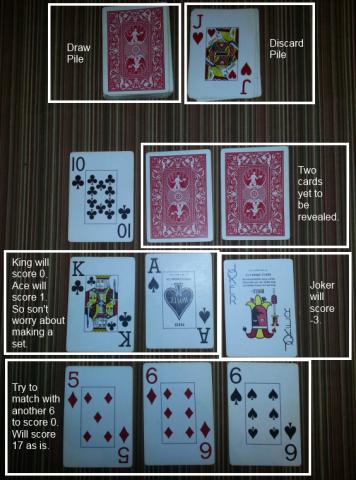Game Makeover: Nines – Initial Assessment
Submitted by John Parker on Oct 26, 2014.
Initial Assessment
Before doing a makeover of the game, I want to consider "what works" and "what needs work" in this initial assessment.
What Works:
Now with the rules understood, let’s see what is good about the game – what works.
- Accessible
- Simple Rules
- Teach/Learn in 2 minutes.
- No rules exceptions.
- Simple Components
- 2 – 3 standard decks of playing cards.
- Scalable
- 2-3 players with 2 decks.
- 4-6 players with 3 decks.
- Can push to as many players as you have decks (yawn).
- Quick Setup (Initial)
- From opening the packs of cards to playing the first hand is about 3 minutes.
- Quick Rounds (Low downtime between plays in a round).
- Typical time for a round is maybe 10-15 seconds per player.
- Quick Hands
- Typical time for a hand is about 5-6 minutes per player.
- Game Length
- Players can decide on a threshold score to end the game (and therefore the approximate duration of the game).
- Scoring
- “Low Score Wins”
- Not rare in card games, but also not that common, trying to score low adds interest to the game.
- Quick and simple scoring method. Though, you need a pad and pencil.
- “Low Score Wins”
- Finish Final Round
- Once one player initiates the end of the hand, all other players get a final turn.
- Streamlined
- A combination of other factors listed here, but the game is just very smooth in operation.
- Cascading (though Random)
- Since discards can often be beneficial to the next player (particularly since many are discarded blindly) it is typical for a bunch of benevolent discards in a row. In the metagame this often resolves to essentially passing the discard to the next player instead of discarding it with a sigh and an, “oh, sure!” (or something close to that).
- Visual
- Building the tableau in front of you has an attraction as well as it provides everyone with easy visual cues as to how close someone is to ending the round..
What Needs Work:
It appears that there is plenty to like about this game (though the reasons may be thin), but what makes it less than great – what needs work? (In no particular order).
- Unmitigated Randomness
- Easily 90+% luck. Make that 98% luck if all players have “card sense.”
- Few Decisions
- There are very few decisions and most are dead simple. (At least, a positive in that is even the most AP prone players don’t have much to cogitate on.)
- Bland
- Although the game is also called 9-Card Golf, it really has no theme. The golf reference is simply related to the similarity to golf in the objective is to score the lowest on 9 cards/holes and in some cases, the game is played in 9 or 18 hands.
- Multiplayer Solitaire
- There is almost nothing a player can do to affect another player.
- The progress of other players is only interesting when they are close to ending the hand.
- Game Length
- The typical score threshold to cause the end of game is 100. The threshold has to be set high enough to mitigate a few random bad hands causing the end, but low enough to mitigate the game overstaying its welcome. Due to high randomness and low variation, that perfect threshold may not exist.
- The end of the game is uncertain and not in full view of the players. (Not uncommon, but I think less than desirable for this simple, already very random game).
- Redundancy
- Play is essentially the same with very little change within a round, a hand, and a game. Someone may press their luck a little more if they need to make a big point swing in the last hand – go for broke – but there is little they can do if the cards aren’t there.
- There is no narrative arc to the game.
- Wasted Information
- The card suit is ignored – half of the information is wasted.
- Wasted Cards (Chaff)
- Many cards have no real value in the game other than as filler. Any card with a value above 5 or 6 is generally ignored in collections unless luck has it that a pair is made quickly. It would seem that if few players are interested in face cards, the one player that is will easily collect them, but another player will be urged to rush to a finish to catch them with lots of points.
- Frustration
- Related to randomness. Since discards are often done blindly, the player often sees that they have discarded something they really wanted. Although, this has a gambling attraction for some.
- Hand Setup
- Although relatively quick in theory, shuffling 162 cards, particularly for a set collection game, every 12 minutes is wearing. (This is when the players refill their tea and chat about the weather.)
- Narrative Arc
- As suggested by the Bland and Redundant issues described, there is no narrative much less a narrative arc to this game. Maybe one isn’t to be expected, but we’ll watch for indications of what can be done.

